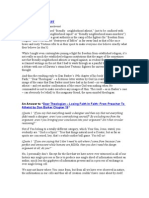New 8
New 8
Uploaded by
Tsumiki OtonashiCopyright:
Available Formats
New 8
New 8
Uploaded by
Tsumiki OtonashiOriginal Title
Copyright
Available Formats
Share this document
Did you find this document useful?
Is this content inappropriate?
Copyright:
Available Formats
New 8
New 8
Uploaded by
Tsumiki OtonashiCopyright:
Available Formats
hoki, Kogo Shui *, and others were copied by medieval Buddhist priests and thus transmitted to
posterity.135 What is the way of thinking that made such an accommodation of Buddhism and
Shintoism possible? The influence of the traditional character of Buddhism cannot be denied, and it is
particularly important to point out the influence of the idea of the One Vehicle manifested in the Hokke
Sutra*. The Imperial Rescript of November of the year 836 A.D. says: "There is nothing superior to the
One Vehicle to defend Shintoism."136 It goes without saying that Nichiren, who expressed his absolute
allegiance to the Hokke Sutra, also showed his genuine loyalty to the Japanese gods and goddesses.
Even the Jodo* followers, who were originally opposed to the gods and goddesses of Shintoism,
tempered their oppositions in a more conciliatory attitude after Zonkaku (1290–1373). The theoretical
basis for such a rapprochement was provided not by the triple-sutras* of the Pure Land Buddhism but
by the Tendai doctrine based upon the Hokke Sutra. The Japanese native gods, exalted as they were as
natural deities, kept their own distinctive existence intact. In this respect they differ completely from the
occidental counterpart in the ancient German gods, vestiges of which remain in the form of the
Christmas festivity (tree, Santa Claus, etc.) within Christianity. The Japanese never considered it
necessary to repudiate their religious faith in the native gods in order to become devoted followers of
Buddhism. In this manner they brought about the conception of "God-Buddhas." It is generally noticed
even today that the ardent Buddhist is at the same time a pious worshipper of Shintoist gods. The
majority of the Japanese pray before the shrine and at the same time pay homage to the temple,
without being conscious of any contradiction. The same relationship as exists in the mind of the
Japanese between Shintoism and Buddhism also holds for the relationship between Buddhism and
Confucianism. When the continental civilization was transplanted to Japan, Buddhism and Confucianism
were simultaneously introduced, without any theoretical conflicts taking place in the minds of the
Japanese or any ideological warfare occurring on Japanese soil. On the contrary, Okura Yamanoue (d.
733), a famous poet, took the conciliatory standpoint that despite the difference existing between
Buddhism and Confucianism, they amount to the same thing: "Although their ways of guiding are two,
both lead up to the one and only one attainment of enlightenment."137 After the dawn of the Modern
era, Confucianism came to flourish with the political backing of the ruling class, and from then on a
doctrine was widely advocated to assert the unity of the three religions, i.e. Shintoism, Confucianism,
and Buddhism. During the Tokugawa period (1600–1867), Kanazoshi* (Tales in Easy Previous Released
By -TSJ5J- Next Previous Released By -TSJ5J- Next Page 392 Japanese, or popular novels written in the
Kana characters) and other similar writings were extremely popular among the common folk. Most of
them were written from the Buddhist point of view, with some exceptions written from the Confucian
standpoint. The most famous of those were The Tale of Kiyomizu, The Tale of Kiyomizu Continued, The
Tale of Gion, The Tale of Daibutsu, and others, all of which were written mainly from the viewpoint of
the unity of the three religions. This was in s
You might also like
- The Subtle Art of Not Giving a F*ck: A Counterintuitive Approach to Living a Good LifeFrom EverandThe Subtle Art of Not Giving a F*ck: A Counterintuitive Approach to Living a Good Life4/5 (6054)
- The Gifts of Imperfection: Let Go of Who You Think You're Supposed to Be and Embrace Who You AreFrom EverandThe Gifts of Imperfection: Let Go of Who You Think You're Supposed to Be and Embrace Who You Are4/5 (1142)
- Never Split the Difference: Negotiating As If Your Life Depended On ItFrom EverandNever Split the Difference: Negotiating As If Your Life Depended On It4.5/5 (917)
- Hidden Figures: The American Dream and the Untold Story of the Black Women Mathematicians Who Helped Win the Space RaceFrom EverandHidden Figures: The American Dream and the Untold Story of the Black Women Mathematicians Who Helped Win the Space Race4/5 (946)
- The Hard Thing About Hard Things: Building a Business When There Are No Easy AnswersFrom EverandThe Hard Thing About Hard Things: Building a Business When There Are No Easy Answers4.5/5 (361)
- Devil in the Grove: Thurgood Marshall, the Groveland Boys, and the Dawn of a New AmericaFrom EverandDevil in the Grove: Thurgood Marshall, the Groveland Boys, and the Dawn of a New America4.5/5 (273)
- The World Is Flat 3.0: A Brief History of the Twenty-first CenturyFrom EverandThe World Is Flat 3.0: A Brief History of the Twenty-first Century3.5/5 (2283)
- A Heartbreaking Work Of Staggering Genius: A Memoir Based on a True StoryFrom EverandA Heartbreaking Work Of Staggering Genius: A Memoir Based on a True Story3.5/5 (233)
- Matter Included in The Confirmation LetterNo ratings yetMatter Included in The Confirmation Letter2 pages
- How the World Really Works - A Scientist's Guide to Our Past, Present and Future 1st Edition Vaclav Smil 2024 scribd download100% (10)How the World Really Works - A Scientist's Guide to Our Past, Present and Future 1st Edition Vaclav Smil 2024 scribd download35 pages
- Amanita Muscaria Herb of Immortality (Psilosophy - Info)No ratings yetAmanita Muscaria Herb of Immortality (Psilosophy - Info)100 pages
- Macroeconomics 12th Edition Michael Parkin Solutions ManualNo ratings yetMacroeconomics 12th Edition Michael Parkin Solutions Manual36 pages
- Spencer L. Allen The Splintered Divine A Study of Ištar, Baal, and Yahweh Divine Names and Divine Multiplicity in The Ancient Near East100% (1)Spencer L. Allen The Splintered Divine A Study of Ištar, Baal, and Yahweh Divine Names and Divine Multiplicity in The Ancient Near East481 pages
- Module+4 World+Religions+From+East+AsiaNo ratings yetModule+4 World+Religions+From+East+Asia27 pages
- Holy Temple of Nzambi, Gnostic Masonic Rite, Sanctus Illuminatus, Brochure of Membership 2014100% (10)Holy Temple of Nzambi, Gnostic Masonic Rite, Sanctus Illuminatus, Brochure of Membership 2014438 pages
- Afuraka-Afuraitkait Nanasom-Nhoma Obueakwan100% (2)Afuraka-Afuraitkait Nanasom-Nhoma Obueakwan59 pages
- Introduction To World Religion and Belief System Lesson 1100% (3)Introduction To World Religion and Belief System Lesson 122 pages
- Alice Getty - Ga Eśa A Monograph On The Elephant-Faced GodNo ratings yetAlice Getty - Ga Eśa A Monograph On The Elephant-Faced God166 pages
- Modern Druidism An Introduction Yowann Byghan All Chapters Instant Download100% (7)Modern Druidism An Introduction Yowann Byghan All Chapters Instant Download82 pages












































































